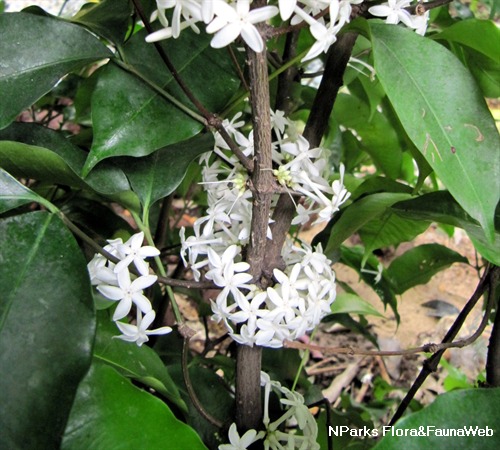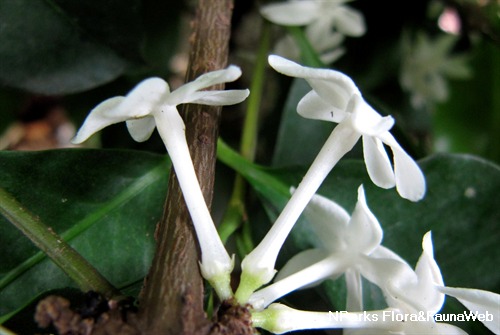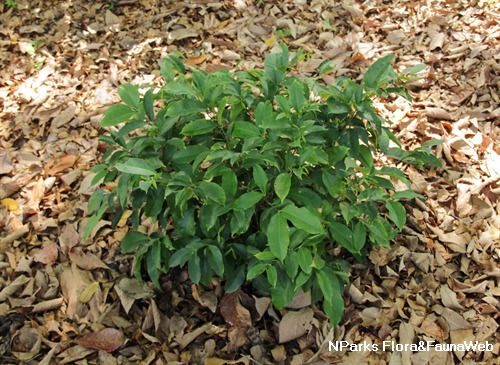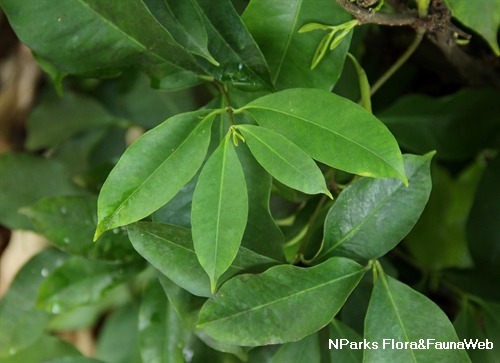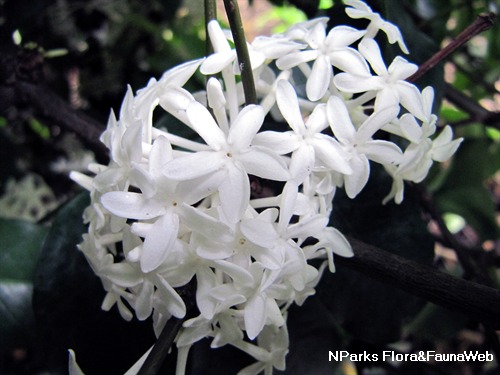
Name
Classifications and Characteristics
| Plant Growth Form | Tree, Shrub |
|---|---|
| Mode of Nutrition | Autotrophic |
| Maximum Height | 7.5 m |
Biogeography
| Native Distribution | Tropical Africa |
|---|---|
| Native Habitat | Terrestrial |
| Preferred Climate Zone | Tropical |
| Local Conservation Status | Non-native |
Description and Ethnobotany
| Growth Form | Large shrub or small tree with rounded growth habit, able to grow up to 8 m tall. |
|---|---|
| Trunk | Bark is smooth and dark brown to pale grey, trunk diameter measuring about 1.5 - 5 cm. |
| Foliage | Opposite, glossy leaves are oblong to elliptic with entire leaf margin (5 - 20 cm long, 2 - 8 cm wide), petiole measuring about 5 - 15 mm long, surface of leaves glabrous. |
| Flowers | White, salverform flowers are star-shaped, having 5 oblong lobes connected to a cylindrical tube, very fragrant. Flowers are borne directly on the branches and woody stems. |
| Fruit | Dry, dehiscent fruits are known as follicles. Fruits are round to ellipsoid and each contains a single seed. Fruit measuring about 13.5 - 20 mm long, seed is brown, globose to oblong, measuring about 7.5 - 12 mm long. |
| Habitat | Found in primary and secondary forests near swamps and rivers. |
| Cultivation | Plant this species in full sun for optimal flowering, but it is tolerant of partial shade. This species is tolerant of waterlogged soils, but it is better to plant in fertile, well-drained soil. Mulch the plants with compost to prevent the soil from drying out or the roots from overheating. Feed plants with a fertilizer rich in phosphorous to promote flowering. Avoid using nitrogen rich fertilizers, because they encourage development of leaves rather than flowers. Try not to prune this species frequently, because flowers are produced from the new growth. |
| Etymology | Genus Pleiocarpa means free-fruiting. |
Landscaping Features
| Landscaping | This species would make an attractive, informal hedge or screen. |
|---|---|
| Desirable Plant Features | Ornamental Flowers, Fragrant |
| Landscape Uses | Parks & Gardens, Small Gardens |
Plant Care and Propagation
| Light Preference | Semi-Shade, Full Sun |
|---|---|
| Water Preference | Moderate Water |
| Plant Growth Rate | Moderate |
| Rootzone Tolerance | Moist Soils, Well-Drained Soils, Fertile Loamy Soils |
| Propagation Method | Stem Cutting |
Foliar
| Mature Foliage Colour(s) | Green |
|---|---|
| Mature Foliage Texture(s) | Smooth, Glossy / Shiny |
| Foliar Type | Simple / Unifoliate |
| Foliar Attachment to Stem | Petiolate |
| Foliar Margin | Entire |
| Foliar Apex - Tip | Acuminate |
| Foliar Base | Cuneate, Rounded / Obtuse |
| Leaf Area Index (LAI) for Green Plot Ratio | 3.0 (Tree - Intermediate Canopy) |
Floral (Angiosperm)
| Flower Colour(s) | White |
|---|---|
| Flower Grouping | Cluster / Inflorescence |
Fruit, Seed and Spore
| Mature Fruit Colour(s) | Yellow / Golden |
|---|---|
| Mature Seed Colour(s) | Brown |
Image Repository
Others
| Master ID | 1777 |
|---|---|
| Species ID | 3070 |
| Flora Disclaimer | The information in this website has been compiled from reliable sources, such as reference works on medicinal plants. It is not a substitute for medical advice or treatment and NParks does not purport to provide any medical advice. Readers should always consult his/her physician before using or consuming a plant for medicinal purposes. |

